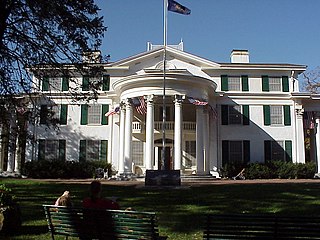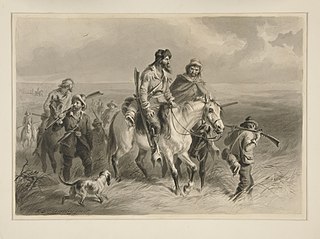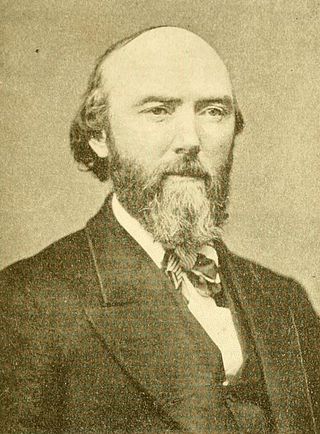
Nebraska City is a city in Nebraska and the county seat of Otoe County, Nebraska, United States. As of the 2020 census, the city population was 7,222.

Bleeding Kansas, Bloody Kansas, or the Border War was a series of violent civil confrontations in Kansas Territory, and to a lesser extent in western Missouri, between 1854 and 1859. It emerged from a political and ideological debate over the legality of slavery in the proposed state of Kansas.

The Territory of Kansas was an organized incorporated territory of the United States that existed from May 30, 1854, until January 29, 1861, when the eastern portion of the territory was admitted to the Union as the free state of Kansas.

The Territory of Nebraska was an organized incorporated territory of the United States that existed from May 30, 1854, until March 1, 1867, when the final extent of the territory was admitted to the Union as the state of Nebraska. The Nebraska Territory was created by the Kansas–Nebraska Act of 1854. The territorial capital was Omaha. The territory encompassed areas of what is today Nebraska, Wyoming, South Dakota, North Dakota, Colorado, and Montana.

In the United States before 1865, a slave state was a state in which slavery and the internal or domestic slave trade were legal, while a free state was one in which they were prohibited. Between 1812 and 1850, it was considered by the slave states to be politically imperative that the number of free states not exceed the number of slave states, so new states were admitted in slave–free pairs. There were, nonetheless, some slaves in most free states up to the 1840 census, and the Fugitive Slave Act of 1850 specifically stated that a slave did not become free by entering a free state.

Border ruffians were proslavery raiders, crossing from the slave state of Missouri into the Kansas Territory, to help ensure Kansas entered the Union as a slave state. They were a key part of the violent period called Bleeding Kansas, that peaked from 1854 to 1858. Their crimes included fraudulent voting, interference with elections, and raiding, intimidating, and destroying property of "Free-State" (anti-slavery) settlers. Some took pride in their criminal reputation. Many became pro-Confederate guerrillas, or bushwhackers.

The Kansas Legislature is the state legislature of the U.S. state of Kansas. It is a bicameral assembly, composed of the lower Kansas House of Representatives, with 125 state representatives, and the upper Kansas Senate, with 40 state senators. Representatives are elected for two-year terms, senators for four-year terms.
Florence is a neighborhood in Omaha, Nebraska, United States on the city's north end and originally one of the oldest cities in Nebraska. It was incorporated by the Nebraska Territorial Legislature on March 10, 1857. The site of Winter Quarters for Mormon migrants traveling west, it has the oldest cemetery for people of European descent and oldest standing gristmill in Nebraska. Florence was the site of an illegal territorial legislature in 1858. Given the high concentration of National Register of Historic Places in the neighborhood, it is regarded as "the historic front door to Omaha as well as the state."

Bristolville is an unincorporated community in central Bristol Township, Trumbull County, Ohio, United States. It lies at the intersection of State Routes 45 and 88 and has a post office with the ZIP code 44402. It is part of the Youngstown–Warren metropolitan area.
The Nebraska Territorial Legislature was held from January 16, 1855 until 1865 in Omaha City, Nebraska Territory.
Racial tension in Omaha, Nebraska occurred mostly because of the city's volatile mixture of high numbers of new immigrants from southern and eastern Europe and African-American migrants from the Deep South. While racial discrimination existed at several levels, the violent outbreaks were within working classes. Irish Americans, the largest and earliest immigrant group in the 19th century, established the first neighborhoods in South Omaha. All were attracted by new industrial jobs and most were from rural areas. There was competition among ethnic Irish, newer European immigrants, and African-American migrants from the South, for industrial jobs and housing. They all had difficulty adjusting to industrial demands, which were unmitigated by organized labor in the early years. Some of the early labor organizing resulted in increasing tensions between groups, as later arrivals to the city were used as strikebreakers. In Omaha as in other major cities, racial tension has erupted at times of social and economic strife, often taking the form of mob violence as different groups tried to assert power. Much of the early violence came out of labor struggles in early 20th century industries: between working class ethnic whites and immigrants, and blacks of the Great Migration. Meatpacking companies had used the latter for strikebreakers in 1917 as workers were trying to organize. As veterans returned from World War I, both groups competed for jobs. By the late 1930s, however, interracial teams worked together to organize the meatpacking industry under the United Packinghouse Workers of America (UPWA). Unlike the AFL and some other industrial unions in the CIO, UPWA was progressive. It used its power to help end segregation in restaurants and stores in Omaha, and supported the civil rights movement in the 1960s. Women labor organizers such as Tillie Olsen and Rowena Moore were active in the meatpacking industry in the 1930s and 1940s, respectively.

The Mayhew Cabin, in Nebraska City, Nebraska, is the only Underground Railroad site in Nebraska officially recognized by the National Park Service. It is included among the sites of the National Underground Railroad Network to Freedom.

Stephen Friel Nuckolls was a Delegate from the Territory of Wyoming and co-founder of Nebraska City, Nebraska. Nuckolls County, Nebraska is named after him.

The history of slavery in Missouri began in 1720, predating statehood, with the large-scale slavery in the region, when French merchant Philippe François Renault brought about 500 slaves of African descent from Saint-Domingue up the Mississippi River to work in lead mines in what is now southeastern Missouri and southern Illinois. These were the first enslaved Africans brought in masses to the middle Mississippi River Valley. Prior to Renault's enterprise, slavery in Missouri under French colonial rule had a much smaller scale compared to elsewhere in the French colonies.

The present-day state of Nebraska was still a territory of the United States during the American Civil War. It did not achieve statehood until March 1867, two years after the war ended. Nevertheless, the Nebraska Territory contributed significantly to the Union war effort.
The First Nebraska Territorial Legislature first met in Omaha, Nebraska, on January 15, 1855. The Council Bluffs and Nebraska Ferry Company provided the first meeting place, which was a building "constructed for public purposes". Standing out from the estimated twenty shacks in the young town, it was the first brick building in Omaha, which was founded the year before when the Nebraska Territory was created. Responsible for several important decisions that laid an important foundation for the future statehood for Nebraska, the Nebraska Territorial Legislature made controversial decisions and provided leadership for the territory.

John Henry Kagi, also spelled John Henri Kagi, was an American attorney, abolitionist, and second in command to John Brown in Brown's failed raid on Harper's Ferry. He bore the title of "Secretary of War" in Brown's "provisional government." At age 24, Kagi was killed during the raid. He had previously been active in fighting on the abolitionist side in 1856 in "Bleeding Kansas". He was an excellent debater and speaker.
The history of slavery in South Dakota is generally seen as short and limited. The issue was contentious for the legislature between the creation of the Nebraska Territory in 1854 and the outbreak of the American Civil War in 1861. However, there was apparently a particular acceptance of African Americans in the Nebraska Territory when they first arrived en masse. According to a publication by the Federal Writers Project,
In the Territory of Nebraska the fight to exclude slavery from within the territorial boundaries spread from the Senate to the press and to the pulpit. Even among the slaves in the South the word spread that here was a place where the attitude toward Negroes was tempered with tolerance.
The history of slavery in Montana is generally seen as short and limited. The issue was contentious for the legislature between the creation of the Nebraska Territory in 1854 and the outbreak of the American Civil War in 1861. However, there was apparently a particular acceptance of African Americans in the Nebraska Territory when they first arrived en masse. According to a publication by the Federal Writers Project,
In the Territory of Nebraska the fight to exclude slavery from within the territorial boundaries spread from the Senate to the press and to the pulpit. Even among the slaves in the South the word spread that here was a place where the attitude toward Negroes was tempered with tolerance.
African Americans in Nebraska or Black Nebraskans are residents of the state of Nebraska who are of African American ancestry. With history in Nebraska from the Lewis and Clark Expedition through the Civil War, emancipation, the Reconstruction era, resurgence of white supremacy with the Ku Klux Klan and Jim Crow Laws, the Civil Right movement, into current times, African Americans have contributed vastly to the economics, culture, and substance of the state.












